Design Optimization and Experimental Verification of Spiral Cone Centrifugal Fertilizer Apparatus Based on the Discrete Element Method
Abstract
:1. Introduction
2. Materials and Methods
2.1. Overall FA Structure and Working Principles
2.2. Analysis and Optimization of Fertilizer Uniform Plate
2.3. Simulation Tests
2.3.1. Establishment of the Simulation Model
2.3.2. Simulation Test Design of Fertilizing Performance of Fertilizer Apparatus in Horizontal State
2.3.3. Simulation Test Design of Fertilizing Performance of Fertilizer Apparatus in a Tilted
2.4. Fertilizing Performance Bench Tests
2.5. Field Tests
3. Results
3.1. Simulation Test Results
3.1.1. Simulation Test Result of Fertilizing Performance of Fertilizer Apparatus in Horizontal State
3.1.2. Simulation Test Result on Fertilizing Performance of Fertilizer Apparatus in a Tilted
3.1.3. Analysis of the Internal Mechanism of Fertilizing Performance Differences
3.2. Bench Test Results
3.3. Field Test Results
4. Conclusions
Author Contributions
Funding
Institutional Review Board Statement
Data Availability Statement
Conflicts of Interest
References
- Wu, S.; Liu, H.; Liu, S.; Wang, Y.; Gu, B.; Jin, S.; Lei, Q.; Zhai, L.; Wang, H. Review of current situation of agricultural non-point source pollution and its prevention and control technologies. Strateg. Study CAE 2018, 20, 23–30. (In Chinese) [Google Scholar] [CrossRef]
- Chen, A. Research strategy of agricultural non-point source pollution. J. Nanjing Tech Univ. Soc. Sci. Ed. 2018, 17, 8–18. (In Chinese) [Google Scholar]
- Huang, Y.; Liu, P.; Gan, M.; Nebiyou, L.; Wang, H.; Gan, X.; Guo, L.; Ma, Y. Application of GIS technology in research of agricultural non-point source pollution. Soils Fertil. Sci. China 2020, 60, 279–285. (In Chinese) [Google Scholar]
- Min, J.; Kong, X. Research progress on agricultural non-point source pollution in China. J. Huazhong Agric. Univ. Soc. Sci. Ed. 2016, 35, 59–66. [Google Scholar]
- Han, Y.; Jia, R.; Tang, H. Research status and development suggestions of precision variable-rate fertilization machine. Agric. Eng. 2019, 9, 1–6. (In Chinese) [Google Scholar]
- Tang, H.; Wang, J.; Xu, C.; Zhou, W.; Wang, J.; Wang, X. Research progress analysis on key technology of chemical fertilizer reduction and efficiency increase. Trans. Chin. Soc. Agric. Mach. 2019, 50, 1–19. (In Chinese) [Google Scholar]
- Liu, X.; Wang, X.; Chen, L.; Zhang, C.; Liu, W.; Ding, Y. Design and experiments of layered and quantitative fertilization device for rapeseed seeder. Trans. CSAE 2021, 37, 1–10. (In Chinese) [Google Scholar]
- Shi, Y.; Chen, M.; Wang, X.; Morice, O.; Li, C.; Ding, W. Design and experiment of variable-rate fertilizer spreader with centrifugal distribution cover for rice paddy surface fertilization [J/OL]. Trans. Chin. Soc. Agric. Mach. 2018, 49, 86–93. (In Chinese) [Google Scholar]
- Han, B.; Liu, Q.; Gao, Y.; Yang, S.; Guo, C.; Dong, X.; Li, Y. Numerical simulation and experiment of seeding performance of seed and medicine mixing device of soybean coating machine. J. Northeast. Agric. Univ. 2020, 51, 79–86. (In Chinese) [Google Scholar]
- Cool, S.; Pieters, J.; Mertens, K.C.; Hijazi, B.; Vangeyte, J. A simulation of the influence of spinning on the ballistic flight of spherical fertilizer grains. Comput. Electron. Agric. 2014, 105, 121–131. [Google Scholar] [CrossRef]
- Xu, B.; Wang, S.; Wu, A.; Ma, B.; Chen, Y.; Xue, Z.; Wang, A. Design of spreading machinery special for greenhouses. J. Agric. Mech. Res. 2017, 39, 158–161. (In Chinese) [Google Scholar]
- Lü, J.; Shang, Q.; Yang, Y.; Li, Z.; Li, J.; Liu, Z. Performance analysis and experiment on granular fertilizer spreader with swing disk. Trans. CSAE 2016, 32, 16–24. (In Chinese) [Google Scholar]
- Jia, F.; Yao, L.; Han, Y.; Wang, H.; Shi, Y.; Zeng, Y.; Jiang, L. Simulation and optimal design of uniform plate of brown rice based on discrete element method. Trans. CSAE 2016, 32, 235–241. [Google Scholar]
- Lan, Z. Design and Experiment of Key Equipment in Rape Plot Seeder. Ph.D. Thesis, Huazhong Agricultural University, Wuhan, China, 2017. (In Chinese). [Google Scholar]
- Yang, R.; Zhang, X.; Li, J.; Shang, S.; Chai, H. Parameter optimization and experiment on cone canvas belt type seed-metering device. Trans. CSAE 2016, 32, 6–13. [Google Scholar]
- Xu, P.; Yang, R.; Shang, S.; Yang, H.; Cui, G.; Liu, L. Experimental study on damaged potato of secondary conveying and separating device. J. Agric. Mech. Res. 2018, 40, 45–49. (In Chinese) [Google Scholar]
- Yang, C.; Shang, S.; Yang, R.; Wang, C. Theoretical study on the cone-centrifugal seed-metering device. J. Agric. Mech. Res. 2015, 37, 63–66. (In Chinese) [Google Scholar]
- Hu, D.; Zhang, L.; Ma, Y.; Dong, W. Performance analysis and experiment of variable fertilizer spreader based on EDEM. J. Agric. Mech. Res. 2022, 44, 177–181. (In Chinese) [Google Scholar]
- Lü, J.Q.; Sun, H.; Dui, H.; Li, Z.; Li, J.; Yu, J. Optimization and experiment of fertilizer particle motion model in conical spreading disk. Trans. Chin. Soc. Agric. Mach. 2018, 49, 85–91. (In Chinese) [Google Scholar]
- Yan, H.; Tang, Z.; Meng, X.; He, Y. Design and performance test of centrifugal type of variable rate fertilizer. J. Gansu Agric. Univ. 2017, 52, 144–149. (In Chinese) [Google Scholar]
- Villette, S.; Pirone, E.; Miclet, D. Hybrid centrifugal spreading model to study the fertilizer spatial distribution and its assessment using the transverse coefficient of variation. Comput. Electron. Agric. 2017, 137, 115–129. [Google Scholar] [CrossRef]
- Sun, Z.; Chen, J.; Duan, J.; Xue, K.; Ou, Z. Design of test bench for centrifugal fertilizer spreader. Mod. Agric. Equip. 2019, 40, 33–37. (In Chinese) [Google Scholar]
- Yang, L.; Chen, L.; Zhang, J.; Sun, H.; Liu, H.; Li, M. Test and Analysis of Uniformity of Centrifugal Disc Spreading. Trans. Chin. Soc. Agric. Mach. 2019, 50, 108–114. (In Chinese) [Google Scholar]
- Hu, Y.G.; Yang, Y.C.; Xiao, H.R.; Li, P. Simulation and parameter optimization of centrifugal 1fertilizer spreader for tea plants. Trans. Chin. Soc. Agric. Mach. 2016, 47, 77–82. (In Chinese) [Google Scholar]
- Guo, H.; Fang, L.; Ye, Y.; Yang, W.; Wang, Z.; Liu, Z. Design and test of the disk-type variable-rate fertilizer feeder based on EDEM. J. Mach. Des. 2019, 36, 67–71. (In Chinese) [Google Scholar]
- Liu, C.; Li, Y.; Song, J.; Ma, T.; Wang, M.; Wang, X.; Zhang, C. Performance analysis and experiment on fertilizer spreader with centrifugal swing disk based on EDEM. Trans. CSAE 2017, 33, 32–39. (In Chinese) [Google Scholar]
- Wang, Y.Q.; Wei, M.; Dong, W.C.; He, J.; Han, C.; Jiang, Z. Design and parameter optimization of a soil mulching device for an ultra-wide film seeder based on the discrete element method. Processes 2022, 10, 2115. [Google Scholar] [CrossRef]
- Sugirbay, A.; Hu, G.; Chen, J.; Mustafin, Z.; Muratkhan, M.; Iskakov, R.; Chen, Y.; Zhang, S.; Bu, L.; Dulatbay, Y.; et al. A study on the calibration of wheat seed interaction properties based on the discrete element method. Agriculture 2022, 12, 1497. [Google Scholar] [CrossRef]
- Liu, X.; Ding, Y.; Shu, C.; Liu, W.; Wang, K.; Du, C.; Wang, X. Design and experiment of spiral disturbance cone centrifugal FA. Trans. CSAE 2020, 36, 34–43. (In Chinese) [Google Scholar]
- Liu, X.; Ding, Y.; Shu, C.; Wang, K.; Liu, W.; Wang, X. Mechanism analysis and test of disturbance and blockage prevention of spiral cone centrifugal FA. Trans. Chin. Soc. Agric. Mach. 2020, 51, 44–54. (In Chinese) [Google Scholar]
- Van, L.; Tijskens, E.; Dintwa, E.; Rioual, F.; Vangeyte, J.; Ramon, H. EDEM simulations of the particle flow on a centrifugal fertilizer spreader. Powder Technol. 2009, 190, 348–360. [Google Scholar]
- NY/T 1143-2006; Technical Specifications of Quality Evaluation for Drills. Ministry of Agriculture of the People’s Republic of China: Beijing, China, 2006.
- Gao, L.; Chen, H.; Liao, Q.; Zhang, Q.; Li, Y.; Liao, Y. Experiment on fertilizing performance of dynamic tilt condition of seeder with deep fertilizer for rapeseed. Trans. Chin. Soc. Agric. Mach. 2020, 51, 64–72. (In Chinese) [Google Scholar]
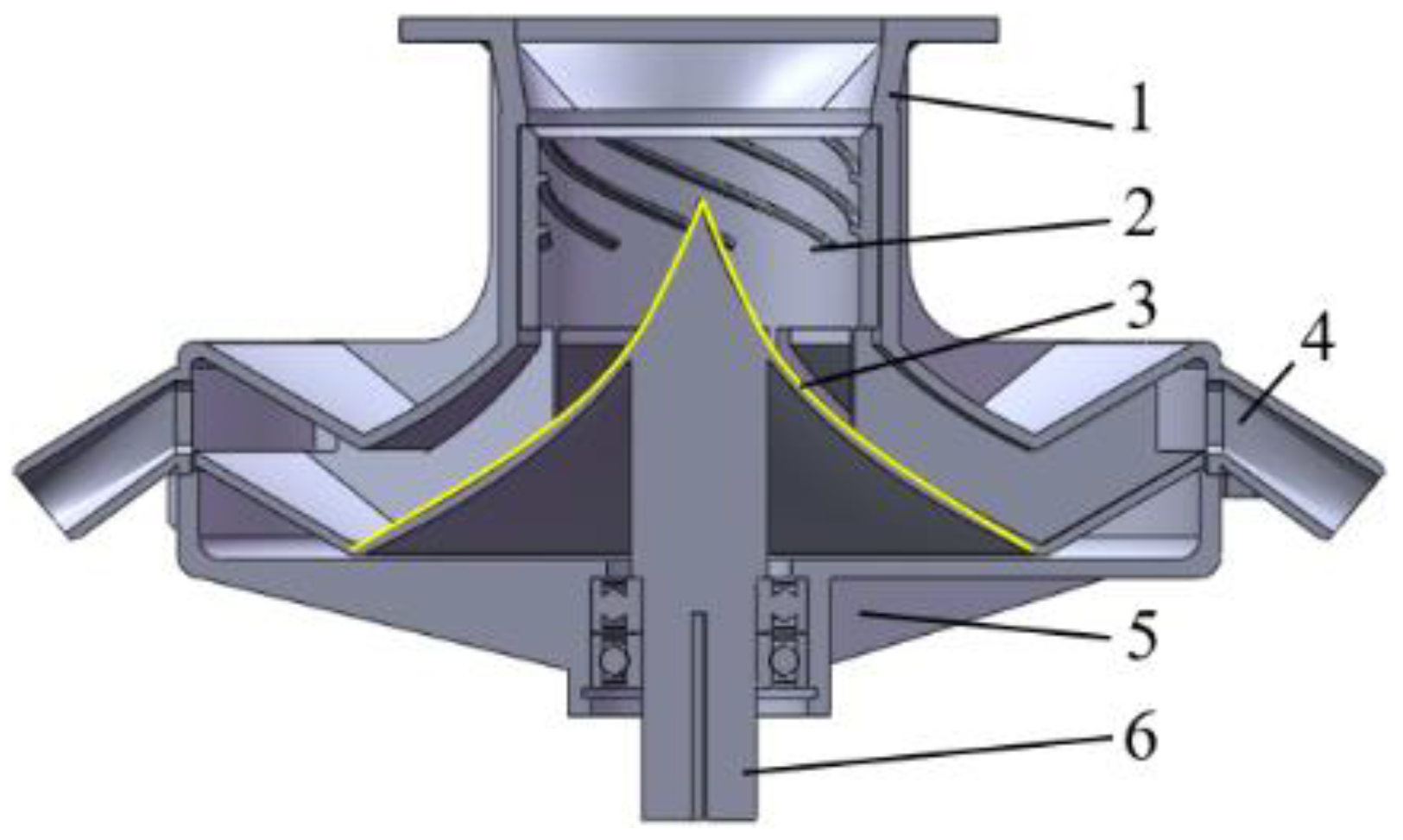
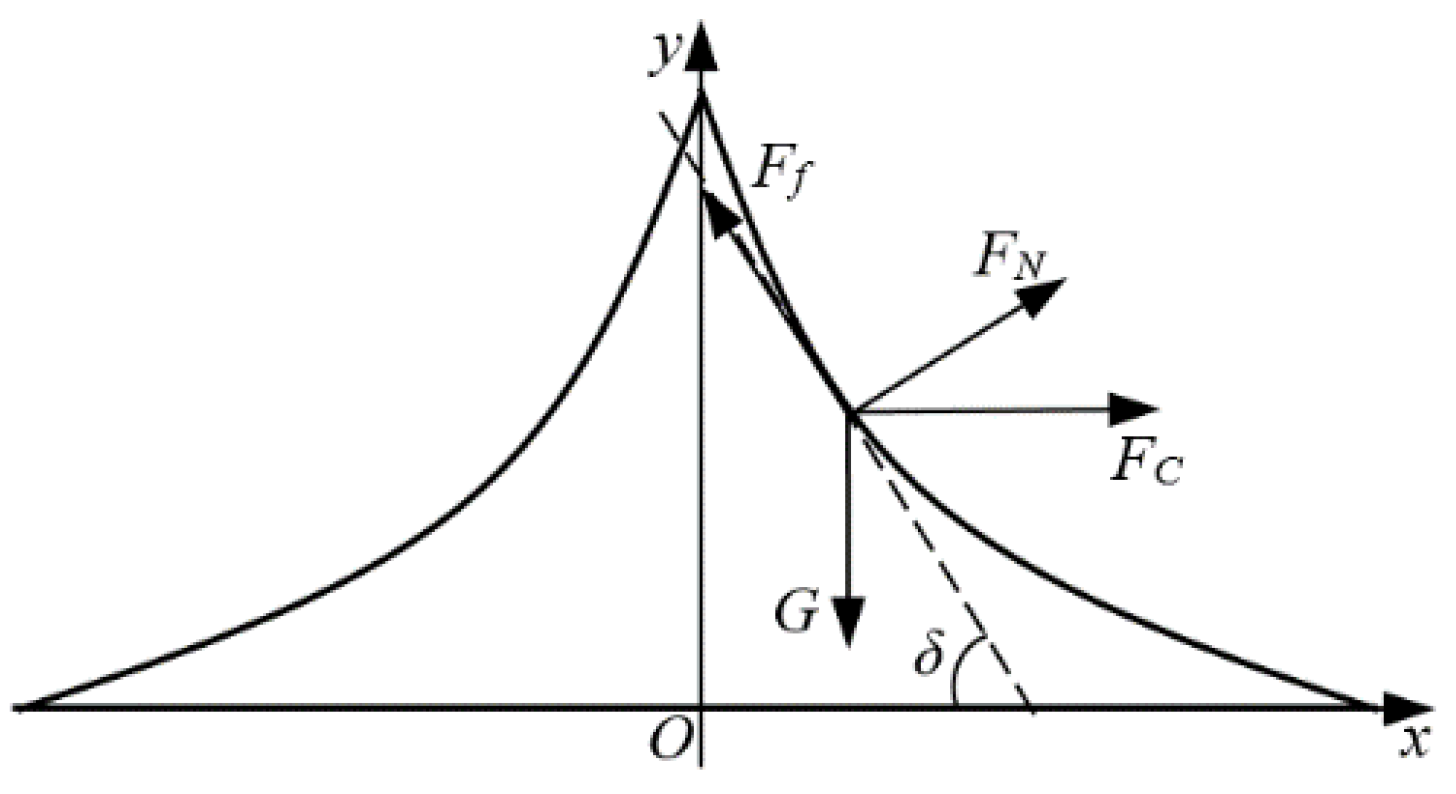
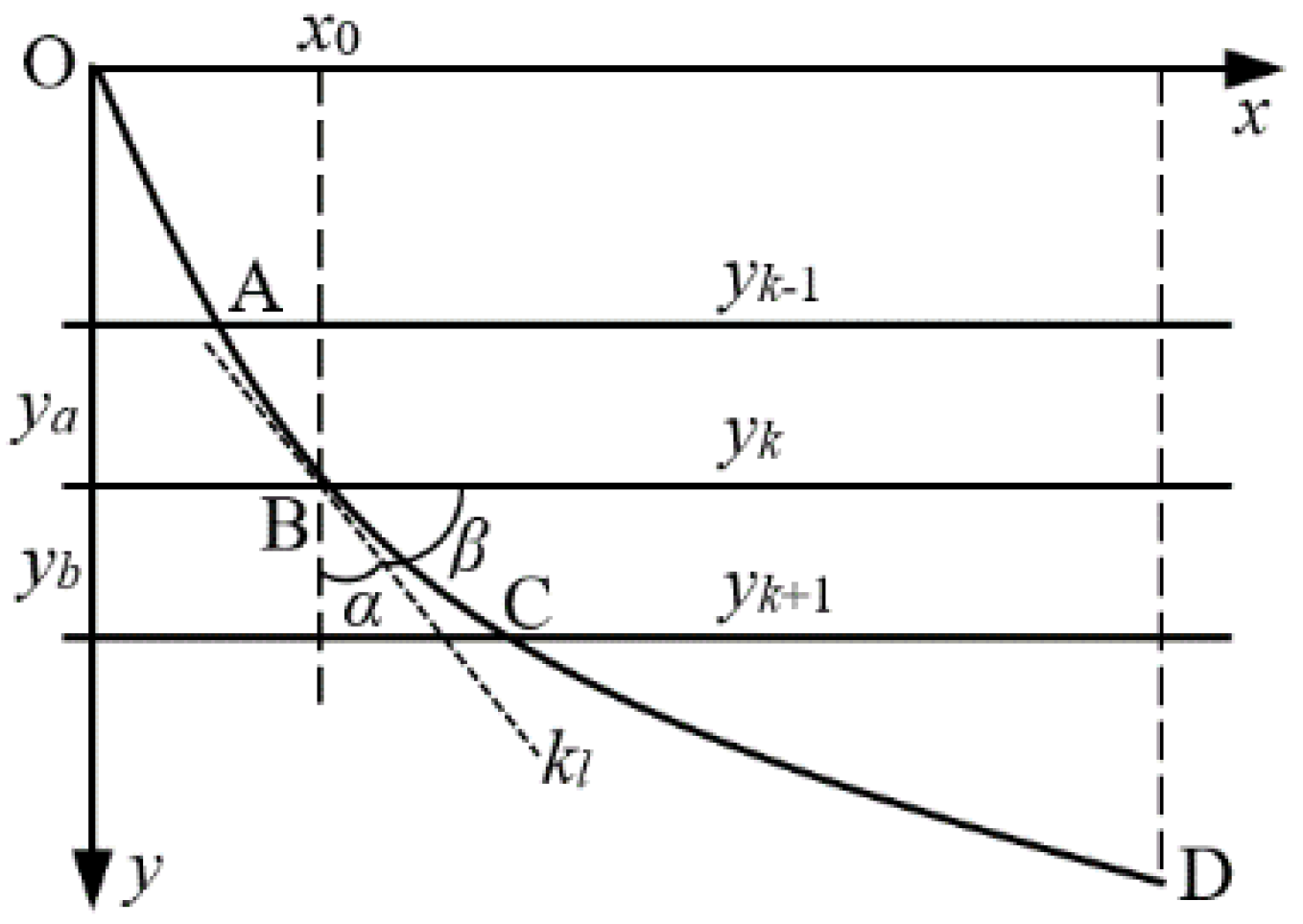





| Rotation time/s | Busbar Forms of ASCD | ||
|---|---|---|---|
| GD-Curvature | GI-Curvature | 0-Curvature | |
| 0 | 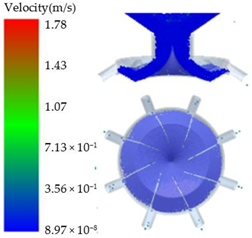 |  |  |
| 0.15 | 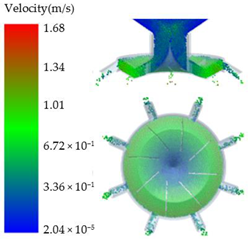 | 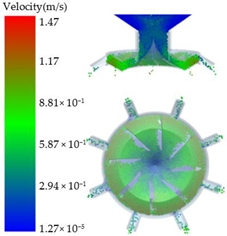 |  |
| 0.6 |  | 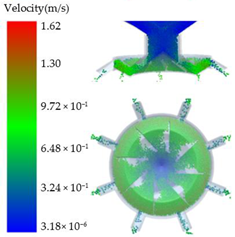 | |
| 1.6 |  | ||
| FA Type | Coned Disk Rotation Speed/(r·min−1) | Fertilizing Pipe Number | Variation Coefficient of Inter-Row Fertilizing Amount Consistency/% | Variation Coefficient of Fertilizing Amount Stability/% | |||||||
|---|---|---|---|---|---|---|---|---|---|---|---|
| 1 | 2 | 3 | 4 | 5 | 6 | 7 | 8 | ||||
| Variation Coefficient of Intra-Row Fertilizing Amount Consistency/% | |||||||||||
| ASCD busbar with GD-curvature | 80 | 1.68 | 2.19 | 1.77 | 1.52 | 2.24 | 2.16 | 1.81 | 2.29 | 7.21 | 4.63 |
| 90 | 1.88 | 2.66 | 0.91 | 0.88 | 1.09 | 1.64 | 1.21 | 0.97 | 5.92 | 3.93 | |
| 100 | 1.47 | 1.15 | 1.61 | 1.64 | 2.19 | 1.23 | 1.22 | 0.94 | 5.05 | 3.28 | |
| 110 | 0.86 | 0.99 | 0.76 | 1.34 | 1.05 | 0.89 | 1.86 | 1.6 | 4.27 | 3.05 | |
| 120 | 1.16 | 1.14 | 1.35 | 0.85 | 0.83 | 1.16 | 0.87 | 1.23 | 3.78 | 2.57 | |
| 130 | 0.98 | 2.07 | 1.32 | 0.94 | 1.22 | 1.37 | 1.43 | 1.42 | 2.75 | 2.33 | |
| ASCD busbar with GI-curvature | 80 | 2.99 | 2.48 | 2.36 | 3.07 | 2.58 | 2.62 | 3.08 | 2.99 | 8.57 | 4.91 |
| 90 | 3.47 | 2.68 | 1.68 | 1.89 | 1.71 | 2.01 | 1.77 | 2.44 | 7.28 | 4.25 | |
| 100 | 1.96 | 2.27 | 2.44 | 2.99 | 2.41 | 2.02 | 1.75 | 2.03 | 6.47 | 3.66 | |
| 110 | 1.68 | 1.68 | 2.13 | 1.85 | 1.66 | 2.66 | 2.4 | 1.69 | 5.32 | 3.44 | |
| 120 | 1.98 | 1.96 | 1.64 | 1.62 | 2.16 | 1.65 | 2.01 | 1.96 | 4.18 | 2.94 | |
| 130 | 2.86 | 1.78 | 1.74 | 2.02 | 2.18 | 2.23 | 2.24 | 2.13 | 3.19 | 2.57 | |
| ASCD busbar with 0-curvature | 80 | 2.84 | 4.29 | 4.17 | 2.96 | 4.05 | 3.56 | 3.89 | 2.31 | 9.32 | 6.09 |
| 90 | 2.82 | 2.42 | 2.49 | 3.00 | 2.40 | 3.32 | 2.89 | 2.50 | 8.15 | 5.37 | |
| 100 | 2.65 | 2.57 | 2.74 | 2.79 | 2.71 | 2.52 | 1.97 | 2.60 | 6.89 | 4.75 | |
| 110 | 2.02 | 2.47 | 2.29 | 2.04 | 2.29 | 2.56 | 3.06 | 2.43 | 5.94 | 4.56 | |
| 120 | 1.88 | 1.50 | 1.74 | 2.22 | 2.02 | 2.12 | 2.55 | 2.47 | 5.02 | 4.03 | |
| 130 | 2.36 | 1.84 | 2.24 | 2.18 | 2.13 | 2.05 | 2.25 | 2.11 | 4.25 | 3.67 | |
| Tilt/° | Coned Disk Rotation Speed/(r·min−1) | Fertilizing Pipe Number | Variation Coefficient of Inter-Row Fertilizing Amount Consistency/% | Variation Coefficient of Fertilizing Amount Stability/% | |||||||
|---|---|---|---|---|---|---|---|---|---|---|---|
| 1 | 2 | 3 | 4 | 5 | 6 | 7 | 8 | ||||
| Variation Coefficient of Intra-Row Fertilizing Amount Consistency/% | |||||||||||
| 0 | 80 | 2.32 | 2.47 | 1.55 | 1.87 | 2.52 | 1.45 | 2.09 | 2.89 | 8.57 | 5.68 |
| 90 | 2.01 | 2.42 | 2.42 | 1.09 | 1.02 | 1.22 | 1.84 | 1.39 | 7.29 | 5.14 | |
| 100 | 1.87 | 2.39 | 1.91 | 2.21 | 1.45 | 1.70 | 2.24 | 2.11 | 5.88 | 4.55 | |
| 110 | 1.46 | 1.60 | 1.08 | 1.47 | 1.58 | 2.16 | 1.65 | 1.75 | 4.61 | 4.29 | |
| 120 | 1.10 | 1.46 | 1.17 | 1.44 | 1.20 | 1.28 | 1.12 | 2.04 | 4.05 | 3.71 | |
| 130 | 1.31 | 1.06 | 1.39 | 1.38 | 1.57 | 1.17 | 1.83 | 1.32 | 2.67 | 3.06 | |
| 5 | 80 | 3.52 | 2.67 | 2.17 | 2.09 | 2.31 | 1.66 | 3.44 | 2.91 | 10.23 | 6.74 |
| 90 | 3.40 | 1.95 | 2.19 | 1.82 | 2.14 | 2.41 | 3.04 | 2.06 | 9.07 | 6.25 | |
| 100 | 1.90 | 2.24 | 1.09 | 1.92 | 2.35 | 1.85 | 1.91 | 1.75 | 8.64 | 5.42 | |
| 110 | 1.71 | 1.40 | 1.53 | 1.90 | 1.82 | 2.19 | 2.23 | 1.77 | 6.37 | 5.01 | |
| 120 | 2.00 | 1.84 | 1.46 | 1.64 | 0.85 | 1.48 | 1.87 | 2.32 | 5.61 | 4.35 | |
| 130 | 1.39 | 1.87 | 1.57 | 1.57 | 1.78 | 1.59 | 1.47 | 1.64 | 4.39 | 3.61 | |
Disclaimer/Publisher’s Note: The statements, opinions and data contained in all publications are solely those of the individual author(s) and contributor(s) and not of MDPI and/or the editor(s). MDPI and/or the editor(s) disclaim responsibility for any injury to people or property resulting from any ideas, methods, instructions or products referred to in the content. |
© 2023 by the authors. Licensee MDPI, Basel, Switzerland. This article is an open access article distributed under the terms and conditions of the Creative Commons Attribution (CC BY) license (https://creativecommons.org/licenses/by/4.0/).
Share and Cite
Liu, X.; Lü, Q.; Li, G.; Wang, J.; Yan, D.; Yang, L.; Liu, E. Design Optimization and Experimental Verification of Spiral Cone Centrifugal Fertilizer Apparatus Based on the Discrete Element Method. Processes 2023, 11, 199. https://doi.org/10.3390/pr11010199
Liu X, Lü Q, Li G, Wang J, Yan D, Yang L, Liu E. Design Optimization and Experimental Verification of Spiral Cone Centrifugal Fertilizer Apparatus Based on the Discrete Element Method. Processes. 2023; 11(1):199. https://doi.org/10.3390/pr11010199
Chicago/Turabian StyleLiu, Xiaodong, Qingqing Lü, Guangxi Li, Jianbo Wang, Dongwei Yan, Liquan Yang, and Erbo Liu. 2023. "Design Optimization and Experimental Verification of Spiral Cone Centrifugal Fertilizer Apparatus Based on the Discrete Element Method" Processes 11, no. 1: 199. https://doi.org/10.3390/pr11010199
APA StyleLiu, X., Lü, Q., Li, G., Wang, J., Yan, D., Yang, L., & Liu, E. (2023). Design Optimization and Experimental Verification of Spiral Cone Centrifugal Fertilizer Apparatus Based on the Discrete Element Method. Processes, 11(1), 199. https://doi.org/10.3390/pr11010199







